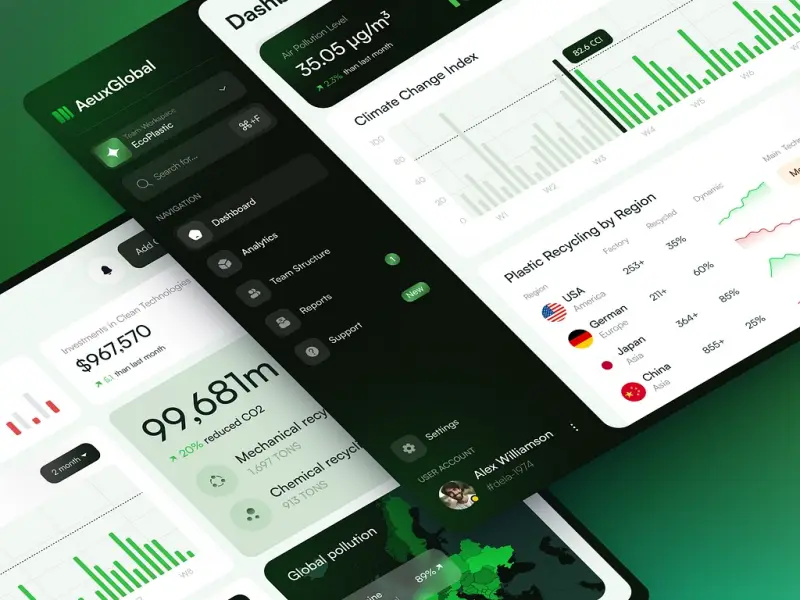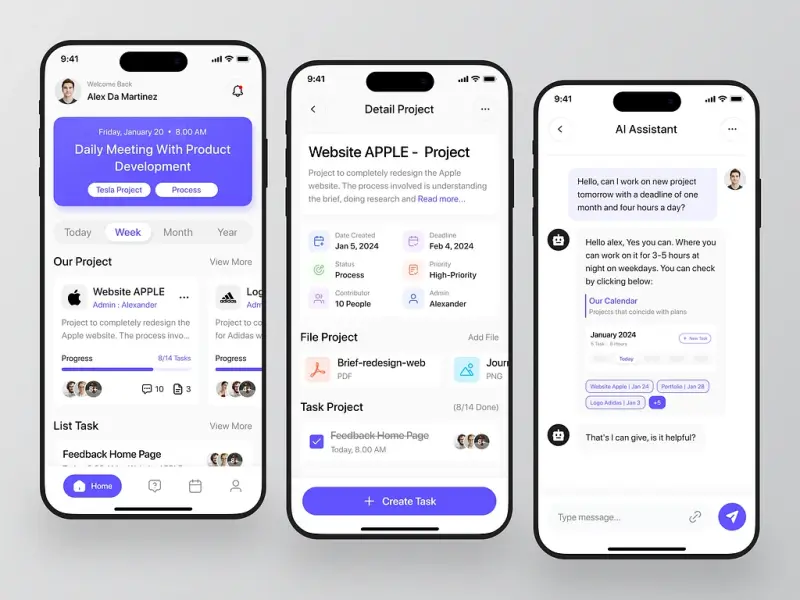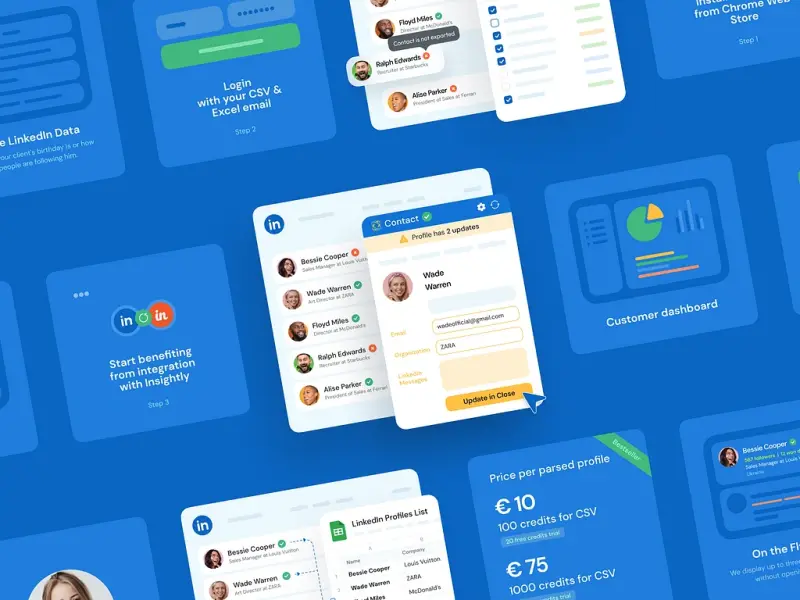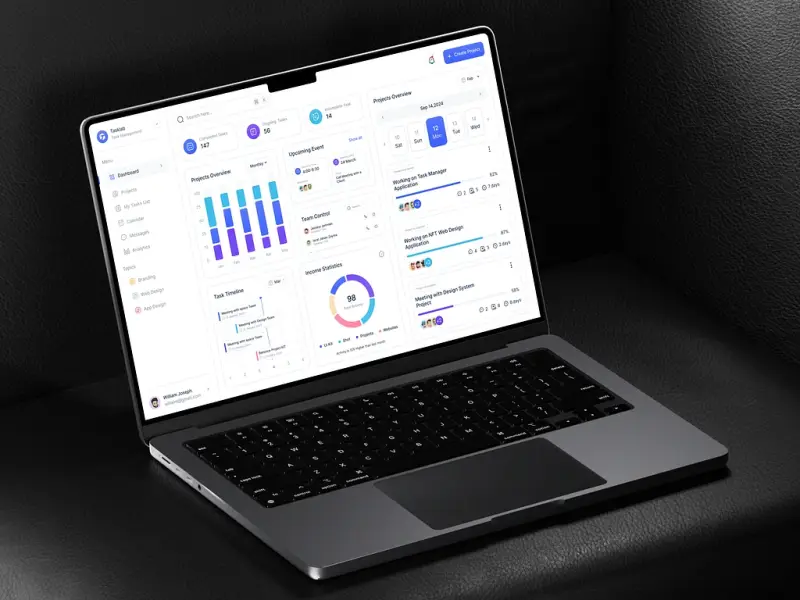20 Profitable SaaS Product Ideas for Entrepreneurs in 2025
- TECHVIFY Team
- January 14, 2025
- Knowledge, Best practices, Guides
- 0 Comments
Software as a Service (SaaS) applications are more than just tools—they’re game-changers. These cloud-based solutions have completely transformed how companies operate, offering unparalleled flexibility, scalability, and accessibility.
With businesses increasingly seeking cost-effective solutions, the demand for SaaS products has skyrocketed. And here’s the exciting part: the SaaS business wave is here, and now is the perfect time to dive in. Waiting too long could mean missing out on opportunities that could define your future success.
That’s why we’ve put together a list of SaaS product ideas that are perfect for startups in 2025. But before we dive into those ideas, let’s take a closer look at the trends shaping the industry and the benefits of the SaaS model.
Why SaaS Is the Perfect Industry for Startups: Market Overview
The SaaS industry is one of the most promising sectors to invest in right now. Why? Because it delivers agility and cost-effectiveness, making it a reliable choice for businesses of all kinds.

SaaS Product Ideas
Still, wondering if the SaaS market is worth your time and investment? Let these numbers speak for themselves. SaaS products are not just trending—they’re transforming industries worldwide. Here are some compelling statistics that highlight why now is the perfect time to dive into this booming sector:
- The global SaaS market is projected to grow from $197 billion in 2021 to an astounding $232 billion by 2025.
- There are currently over 59 billion SaaS customers worldwide, and the number is growing every year.
- The SaaS market is forecasted to expand at a compound annual growth rate (CAGR) of 13.7% from 2023 to 2030.
These figures underscore the enormous potential of the SaaS industry, making it one of the most lucrative niches for startups today.
Beyond its impressive growth stats, the SaaS industry is a favorite among venture capitalists, thanks to its scalability and recurring revenue model. Take a look at some recent funding examples that showcase the confidence investors have in SaaS product ideas:
- Icertis, a SaaS startup, raised $150 million in funding from Silicon Valley Bank.
- Zylo, a SaaS management platform for enterprises, secured $31.5 million in its latest funding round.
- Unito, a SaaS platform for workflow management, completed a $20 million Series B funding round.
- Slide, a Saudi Arabia-based startup, raised $1.75 million in a pre-seed funding session.
- Nigerian SaaS startup Bump successfully raised $4 million in a seed round.
These numbers highlight one thing: SaaS startups are thriving. If you’ve been thinking about launching a SaaS product, exploring the best SaaS product ideas can help you get started on the right path.
Learn More On:
Essential SaaS Benefits Driving Mainstream Adoption
Did you know that the average SaaS startup idea generates approximately $10M in annual recurring revenue (ARR) within just over five years? It’s no surprise then that SaaS application ideas are a hotbed of innovation, attracting entrepreneurs and startups eager to tap into this booming market.
Greater Business Agility
Business agility refers to how quickly and effectively a company can adapt to changes in the market, customer demands, or technology. According to a study by AbsolutData, businesses that excel in agility outperform their competitors, making this attribute essential for modern startups.
The SaaS model is uniquely equipped to enhance agility. By offering subscription-based software, startups can access powerful tools without the upfront costs of traditional systems. They can scale usage up or down and even switch providers when necessary—all without the hassle of managing software updates or maintenance.
This freedom allows businesses to focus on their core goals: improving productivity, building innovative products, and staying competitive in a rapidly changing market.
Unmatched Scalability
Scalability is often the most celebrated benefit of SaaS solutions—and for good reason. As your startup grows, so do its demands. SaaS applications make it seamless to scale resources up or down, ensuring that your business evolves in step with its needs.
But scalability isn’t just about growth. SaaS enables startups to allocate resources more strategically, thanks to the elasticity of cloud computing power. This flexibility helps reduce operational costs while maintaining performance.
For example, imagine you’re launching a new SaaS app. Initially, you might need limited resources to get started. But as your user base grows, the platform can scale effortlessly to handle increased traffic—no downtime, no stress.
True Location Independence
One of the most exciting aspects of SaaS is its ability to break down geographical barriers. With cloud-based tools, your target audience doesn’t have to be limited by location. You can reach customers anywhere in the world, as long as they have an internet connection.
This flexibility also extends to your team. SaaS enables businesses to hire top talent from across the globe, embracing remote work without sacrificing productivity. Imagine assembling a world-class team of developers, designers, and marketers—all collaborating seamlessly on your SaaS product from different corners of the planet.
This location independence opens up endless possibilities for startups, allowing founders to think big and act boldly, without being tied to traditional business models.
Looking to Build a SaaS Application?
Contact TECHVIFY – Vietnam’s Leading Offshore Software Development & Outsourcing Company, for consultation and development services.
Transformative SaaS Ideas to Explore in 2025
The SaaS industry continues to reshape the way businesses operate, offering countless opportunities for innovation with exciting SaaS product ideas. Whether you’re a startup founder, a developer, or an entrepreneur seeking good SaaS ideas, the SaaS space is thriving with possibilities. Below, we explore seven of the best SaaS product ideas that could unlock growth, inspire innovation, and help you make a lasting impact.
Best SaaS product ideas
1. Telehealth
The telehealth market is on track to reach $396 billion by 2027, and for good reason—it’s revolutionizing healthcare. Companies like American Well and Teladoc Health Inc. have already shown how telemedicine can disrupt traditional healthcare systems by enabling virtual consultations and remote diagnostics.
But this isn’t just a space for the giants. For entrepreneurs, telehealth SaaS solutions tailored to specific industries, geographies, or medical specializations represent a golden opportunity. Imagine creating a telehealth platform designed specifically for rural areas, mental health services, or chronic condition management—there’s plenty of room to innovate.
Pros:
- Explosive industry growth.
- Niche markets are ripe for disruption.
- Substantial funding opportunities in healthcare innovation.
Cons:
- Strict regulatory requirements.
- High entry barriers due to legal and operational complexity.
- Potential legal risks, including liability and litigation.
2. Marketing Automation
Marketing is a critical factor in startup success, yet many businesses struggle to execute it effectively. This is where marketing automation SaaS platforms step in, helping companies automate emails, SMS, and other communication channels to save time and boost efficiency.
The market is undeniably competitive, but the payoff is equally significant. Even capturing 1-3% of this massive market can result in a thriving business. Success stories like Omnisend, Klaviyo, and Mailchimp (which recently exited for $12 billion) highlight the vast potential in this space.
Pros:
- Enormous market size—small shares can lead to big wins.
- Well-defined user pain points and needs.
- Clear go-to-market paths based on established players.
Cons:
- Extremely competitive space.
- Customers demand robust features from day one.
- Price competition is fierce, with many low-cost alternatives.
3. Social Media Management
Social media is a cornerstone of modern marketing, with billions of users engaging across platforms daily. SaaS tools like Hootsuite, Buffer, and We Are Social have proven the demand for social media management software, enabling users to create, schedule, and analyze content effortlessly.
While building a social media management platform is relatively simple in terms of product development, the market is heavily saturated. Differentiation—whether through niche targeting or innovative features—will be key to standing out.
Pros:
- Straightforward product development process.
- Well-educated users with clear expectations.
Cons:
- Highly competitive market with numerous established players.
- API changes and platform-specific limitations require frequent updates.
- Products must support all major social platforms, adding complexity.
4. Content Planning
In the digital age, “content is king.” Businesses rely heavily on content marketing to engage audiences, build trust, and drive growth. However, creating and executing a content strategy is no small task, which is why content planning SaaS tools are in high demand.
These platforms can assist with content generation, competitive analysis, and optimization, helping businesses stay ahead in the ever-changing digital landscape. While the niche is smaller compared to others, the growing importance of content marketing makes this a compelling opportunity.
Pros:
- Exploding demand in the content marketing space.
- Early adopters are open to trying innovative tools.
Cons:
- Smaller market compared to broader SaaS categories.
- Many users rely on free alternatives like Google Docs, making differentiation crucial.
5. Email & SMS Marketing Software
Email and SMS marketing remain two of the most effective ways to drive sales and engagement. Despite their proven success, many businesses underutilize these channels, leaving a gap for innovative SaaS solutions.
Platforms like Sender have gained traction by offering affordable, user-friendly tools that combine email and SMS marketing in one dashboard. Features like automation, segmentation, and drag-and-drop builders make these platforms indispensable for small businesses looking to grow without overspending.
Pros:
- Unified email and SMS marketing in one place.
- Affordable and accessible to smaller businesses.
- Pre-made templates and an intuitive interface simplify adoption.
Cons:
- Limited advanced features (e.g., landing page builders).
- Test emails can only be sent to a single address, which may frustrate power users.
6. Customer Relationship Management (CRM)
Customer relationships are at the heart of every successful business. That’s why CRM software has become essential for managing interactions, improving retention, and driving growth.
While companies like Salesforce and Oracle dominate the market, their tools are often complex and outdated, leaving room for more intuitive, niche-focused solutions. A modern CRM platform tailored to small businesses or specific industries could easily disrupt this space.
Pros:
- Large deal sizes with pricing based on users/seats.
- The market is ready for innovation with more user-friendly and industry-specific tools.
Cons:
- Competitive landscape with well-established incumbents.
- Requires a sales-led go-to-market strategy, which can be resource-intensive.
7. Video Creation and Editing
Video is the future of content marketing. Forbes predicts that by 2025, video will account for 82% of all internet traffic. This makes video creation and editing SaaS platforms one of the most exciting opportunities in the market.
While companies like Adobe Premiere and After Effects dominate the professional space, smaller, user-friendly tools like VEED and Funimate have proven that there’s demand for simpler alternatives. With advances in AI-powered video generation, the potential for disruption in this space is enormous.
Pros:
- Video content continues to grow in demand.
- Opportunities to disrupt an industry dominated by complex, expensive software.
- AI innovations open up new possibilities for video rendering and editing.
Cons:
- High competition with many free alternatives.
- Many potential users are unwilling to pay for video editing tools.
8. Workforce Management
The post-pandemic workplace has brought new challenges for employers. Managing teams—especially with the rise of remote work—has become more demanding than ever. Tools that streamline workforce management are no longer just convenient; they’re critical for businesses to thrive in this evolving landscape.
Thanks to platforms like Paylocity and flair.hr, employers now have innovative solutions to manage their teams efficiently. These tools have become indispensable for many organizations, proving their value in times of uncertainty.
Pros
- High revenue potential (pricing is typically per employee for SMBs and enterprise businesses).
- The demand for workforce management tools is skyrocketing due to the normalization of remote work.
Cons
- Marketing and sales can be challenging (intense competition and long sales cycles).
- High barriers to entry, particularly in terms of product development.
9. In-Depth Pricing Plans
With services readily available online, businesses face a new challenge: navigating inconsistent or outdated pricing information. When service providers frequently update their prices, customers often struggle to find accurate details.
This is where pricing aggregation tools like Data Crops excel. By providing real-time, accurate pricing data, these platforms simplify the decision-making process for users and eliminate frustration.
Why This SaaS Niche Works
Building an app in this space is a smart move—it’s a practical and relatively untapped niche. If you’re looking for a promising SaaS idea, this might be your opportunity.
Pros
- The niche is not overly saturated, offering room for innovation.
- No need for a dedicated sales team (a marketing-led go-to-market strategy works well).
Cons
- Developing such a product can be complex and resource-intensive.
- Strong customer support will likely be required from day one.
Let’s talk
A consultation with the Client Relationship Manager, who represents TECHVIFY, without any commitment from your side, will give you:
- Structured and clear vision of your future application
- Information about how our software development company guarantees 100% on-time and on-budget delivery
- Recommendations for choosing the tech stack
- Advice on further steps
- Business-side recommendations
- Rough project estimation on software development
TECHVIFY is right where you need. Contact us now for further consultation:
10. E-Learning Platforms
In today’s fast-paced digital world, having tech skills is no longer optional—it’s essential. Whether someone dreams of a career in Digital Data Design, Visualization, or Data Science, they need the right tools to acquire these skills.
Creating e-learning platforms that help individuals enhance their capabilities is a fantastic SaaS opportunity. As reported by The Brookings Institution, technology and IT are driving America’s economic growth, making this an ever-relevant space.
Pros
- The e-learning industry is booming, with increasing demand for online education.
- People are willing to invest in skill-building courses for career advancement.
Cons
- The space is dominated by established players with extensive, high-quality content.
- Marketing and sales can be complex in such a competitive environment.
11. OKR (Objectives and Key Results) Tracker
OKR trackers simplify goal-setting and progress measurement, helping businesses align their teams and enhance performance. With features like actionable insights and transparent progress reports, these tools enable better collaboration, communication, and efficiency.
Good SaaS ideas
Companies like Ally, Profit.co, and Adobe have already tapped into this growing space. However, there’s still room for new entrants, as the concept of OKR is steadily gaining traction across industries.
Pros
- The OKR methodology is growing in popularity year after year, creating ongoing demand.
- Products in this niche are relatively straightforward to build compared to other SaaS ideas.
Cons
- Selling to larger companies often requires a dedicated sales team.
- Enterprise clients typically demand robust, feature-rich solutions.
12. Property Management Platforms
The real estate industry is vast, with property owners often struggling to manage diverse and complex portfolios. Property management platforms like Buildium, TenantCloud, and AppFolio have stepped in to solve this problem, offering tools to simplify operational tasks for landlords and property managers.
If you’re considering building a SaaS tool, this niche offers a promising opportunity. However, understanding your target audience’s specific needs is critical to success in this space.
Pros
- A focused vertical SaaS niche with high demand.
- Marketing and customer acquisition strategies are relatively straightforward.
Cons
- Industry expertise is required to build a truly effective product.
- Addressing the diverse needs of property managers can be challenging.
13. Sales Tracking Apps
Monitoring sales performance is a critical task for e-commerce and B2B businesses, yet it’s often time-consuming and inefficient. Developing a sales tracking app can help companies streamline this process, offering actionable insights and improving overall efficiency.
Established players like HubSpot Sales and Freshsales have already demonstrated the demand for these tools. While competition exists, there’s room for innovation in creating more tailored or feature-rich solutions.
Pros
- Sales tracking apps are relatively easy to develop.
- High demand across both B2B and B2C segments.
Cons
- Selling to sales professionals can be challenging (they tend to scrutinize solutions heavily).
- These apps often perform best as part of a larger suite of tools rather than standalone products.
14. Virtual Universities
The shift to online education has opened doors for entirely virtual universities, where students can access courses anytime, from anywhere. Imagine creating an app that replicates the university experience with a gamified twist—students could attend virtual classes, participate in events, and even unlock achievements as they progress.
This SaaS idea offers enormous potential, but it also comes with its share of challenges. Universities are keen to digitalize, but their requirements are often specific and complex.
Pros
- A rapidly growing market as universities increasingly adopt digital models.
- Huge potential for innovation, particularly with features like gamification.
Cons
- Selling to universities involves long sales cycles and numerous requirements.
- Developing a feature-rich product for this space can be resource-intensive.
Learn More On:
15. Interview Tracking System
Recruitment processes can often feel overwhelming. From tracking candidates to scheduling interviews and preparing assessments, the responsibilities can quickly pile up for anyone managing hiring workflows.
This is where an interview tracking system can transform the process. By automating and organizing recruitment stages, such a tool simplifies candidate management, leaving recruiters with more time to focus on selecting the best talent.
Platforms like Pinpoint and flair.hr have successfully entered this space, offering comprehensive solutions to recruitment challenges. However, there’s still room for innovative tools that cater to more specific needs or under-served niches.
Pros
- Relatively simple to develop compared to other SaaS products.
- The opportunity to target both B2B (recruitment firms, HR teams) and B2C (freelance recruiters or small businesses).
Cons
- Highly competitive and saturated market.
- Building integrations with other HR tools is essential to make the product valuable and usable.
16. Stock Market Valuation Tool
Investing in the stock market appeals to many, but not everyone feels confident navigating it. For beginners and seasoned traders alike, evaluating whether a stock is undervalued or overvalued can be a daunting task.
Most profitable SaaS ideas
A stock market valuation tool, like Finbox, solves this problem by providing users with actionable insights into stock prices, growth potential, and risk factors. Such tools aggregate data from APIs and present it in an accessible format, empowering investors to make informed decisions.
Why It’s a Great SaaS Opportunity
The interest in stock market trading is surging, and with widely available APIs, creating a valuation tool doesn’t have to be overly technical.
Pros
- A thriving niche fueled by the growing popularity of stock market investing.
- Access to APIs simplifies development and reduces technical complexity.
Cons
- The market is highly volatile, which could impact user retention.
- Legal and liability risks require careful compliance and transparency.
17. Investor Journal
For active traders with high-frequency transactions, keeping track of every buy-and-sell action is critical. While this might not be an issue for long-term investors, day traders executing dozens of trades daily need a reliable solution to document their activity.
An investor journal SaaS tool can automate trade logging, generate reports, and help users analyze their trading patterns. Such a platform caters to a niche audience of active retail investors and traders looking to optimize their strategies.
Pros
- Straightforward to develop, with minimal technical complexity.
- No need for a dedicated sales or support team, as the product can often sell itself through targeted marketing.
Cons
- Marketing may be challenging and require creative strategies to attract users.
- Building a successful product may require prior experience or deep knowledge of investing.
18. Virtual AI Chatbot Solution
As the number of digital buyers continues to grow, businesses face increasing pressure to provide seamless customer support around the clock. Managing this manually is resource-intensive, but a virtual AI chatbot offers a scalable, efficient alternative.
By automating customer interactions, chatbots can handle inquiries, resolve common issues, and even assist with sales. Platforms like Intercom and Drift have demonstrated the demand for such solutions, but there’s still potential to create niche-specific chatbots tailored to particular industries or use cases.
Pros
- One of the easiest SaaS products to develop, especially with advancements in AI and NLP (natural language processing).
- High demand, particularly in B2C industries like e-commerce and customer service.
Cons
- Monetization can be challenging due to low pricing models in this space.
- Low customer retention and lifetime value (LTV) due to the commoditization of chatbot technology.
19. Travel Itinerary Platform
Travel planning is often exciting, but creating a detailed itinerary can quickly become tedious and time-consuming. Whether it’s juggling flight schedules, hotel bookings, or activities, travelers often feel overwhelmed with the logistics of organizing a trip.
A travel itinerary platform, like Travefy or Umapped, helps users streamline this process by consolidating all travel details into one easy-to-manage app. Such tools appeal to both individual travelers and travel agencies looking to enhance their client offerings.
Why This Niche is Growing
As the travel industry rebounds in a post-pandemic world, there’s increased demand for digital solutions that simplify trip planning.
Pros
- A rapidly growing market with opportunities for innovation.
- Few existing solutions, leaving room for differentiation and niche targeting.
Cons
- Requires a customer success and sales team to ensure a smooth go-to-market strategy.
- Industry connections and expertise are valuable for building a competitive product.
20. Email Delivery Solutions
Email marketing remains one of the most profitable digital marketing channels, with an average ROI of $36 for every $1 spent. However, delivering emails successfully—without them landing in spam folders—requires robust infrastructure and expertise.
An email delivery solution, like Sendinblue, MailChimp, or ActiveCampaign, can help businesses manage email campaigns, enhance deliverability, and analyze campaign performance. While the market is competitive, there’s potential for niche-focused solutions that cater to specific industries or use cases.
Pros
- A massive market with significant revenue potential—even capturing 1% of the market can lead to substantial profits.
- High demand across businesses of all sizes, from startups to enterprises.
Cons
- Extremely competitive space dominated by established players.
- High technical barriers to entry, requiring expertise in email infrastructure and deliverability optimization.
Conclusion
The SaaS industry is full of untapped potential, offering countless opportunities to create innovative and profitable products. From simplifying recruitment processes to empowering investors and enhancing travel planning, the right SaaS product can solve real-world problems and drive meaningful business growth.
However, turning an idea into a scalable, market-ready product takes more than inspiration—it requires technical expertise, strategic planning, and flawless execution.
At TECHVIFY, we specialize in building custom SaaS solutions tailored to your unique vision. Let us help you create a product that not only stands out but delivers measurable results.
TECHVIFY – Global AI & Software Solution Company
From Startups to Industry Leaders: TECHVIFY prioritizes results, not just deliverables. Accelerate your time to market and see ROI early with high-performing teams, AI (including GenAI) Software Solutions, and ODC (Offshore Development Center) services.
- Email: [email protected]
- Phone: (+84)24.77762.666








